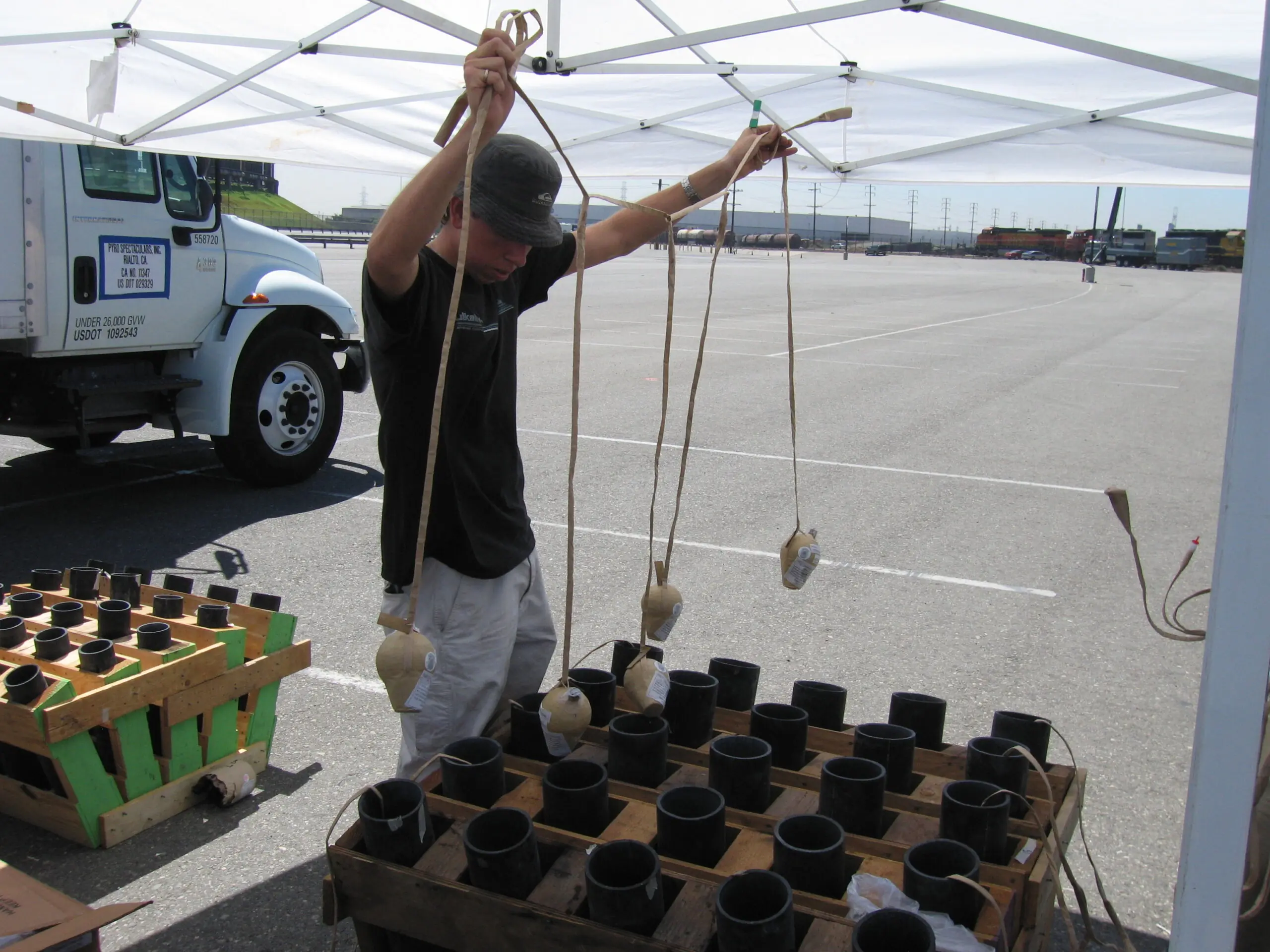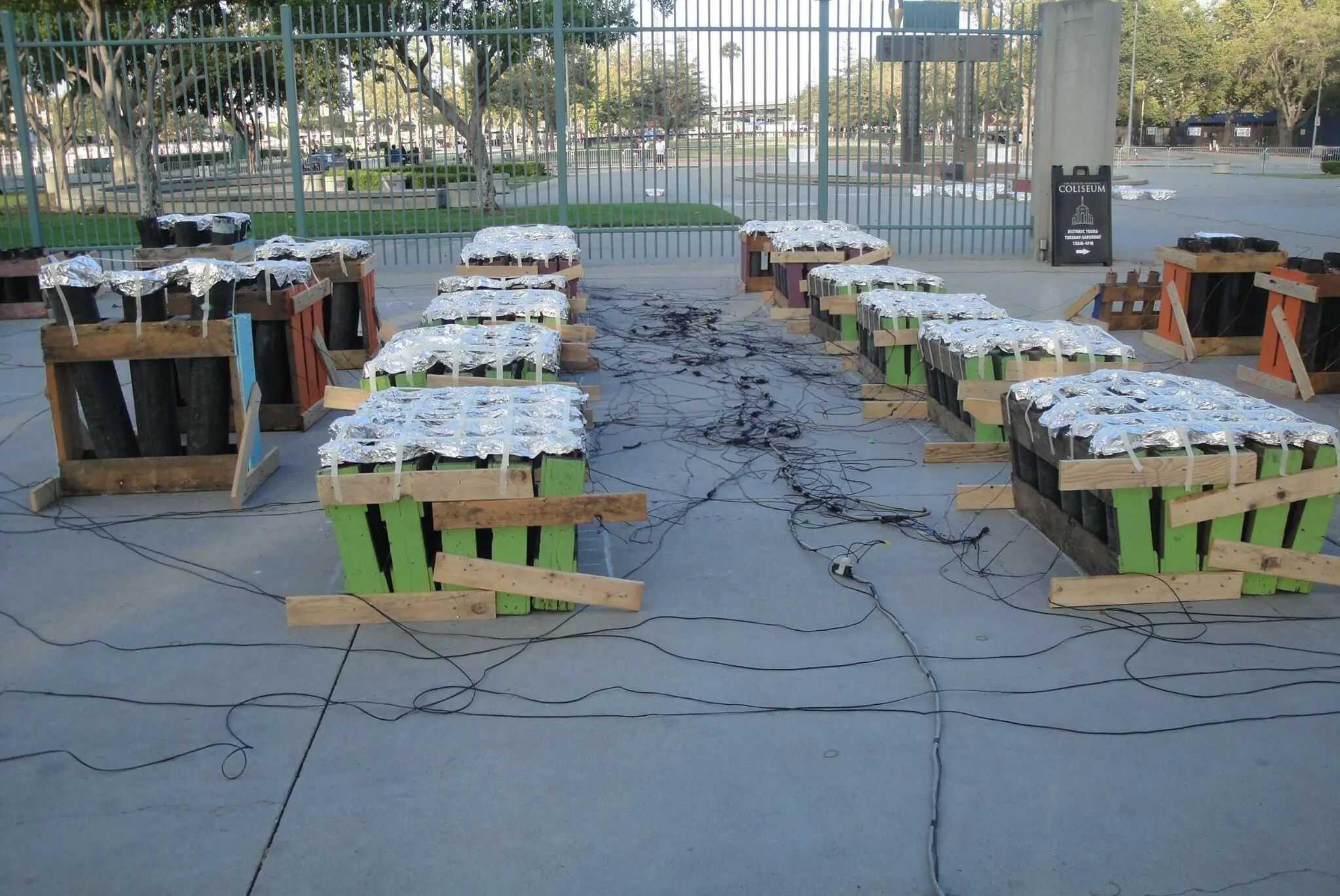Take me back to what to know your first fireworks show
Fireworks Finale Setup
Setting up the racks for a finale is similar, but different to that of the main body of the show. We cleat finale racks at an angle.
Why do we cleat finale racks at an angle?
Would you rather see a clump of shells in the same spot in the sky, or the entire sky filled from horizon to horizon with those same shells? We angle the racks so that we fill the entire night sky with fireworks. This is the last part of your show and you want it to completely overwhelm the audience with light, sound, and emotion. The amount of angle you put in your racks is determined mainly by the clearance you have at your firing site. The larger the angle, the bigger the spread, and the more sky you fill, but also the more distance you need downrange. Be consistent with the angle between each rack so that you have an even spread of shells in the air. Make sure the base of the racks are all touching, as this provides the most stability and the biggest spread for the given separation. Learn how to cleat fireworks finale racks.

How do I load finale chains?
A finale chain is a chain of shells (usually 5) that are quick matched together and made to function in rapid succession from a single ignition.
Finale Chains Are Loaded “Across” the Finale Racks – If you are facing the audience with the racks in front of you, and stringing the chains from left to right. This way, the chains fire “across the sky” and you avoid the same effect as cleating your guns straight up. If you don’t load your shells “across” you will see a ball of fire on the right, then a ball of fire next to it, and so on and so forth. Your sky will then never be “filled.”
Keep Your Shells Untangled – Each shell will be branched off of the main quick match lead in a finale chain. Make sure you keep each shell in the order that it is attached to the chain. This will help prevent quick match blowouts during the show. When quickmatch fires, it’s so violent that it pretty much explodes as it’s “burning.” Tuck exceed quickmatch into the mortars so that you don’t chance having a piece of match belonging to a shell that has yet to get fired being blown apart from being tangled over another mortar.
Keep Your Finale Shells Untangled
Each shell will be branched off of the main quick match lead in a finale chain. Make sure you keep each shell in the order that it is attached to the chain. This will help prevent quick match blowouts during the show. When quick match fires, it’s so violent that it pretty much explodes as it’s “burning.” Tuck exceed quickmatch into the mortars so that you don’t chance having a piece of match belonging to a shell that has yet to get fired being blown apart from being tangled over another mortar.

Connecting Fireworks Finale Chains
If you have, let’s say, 5 chains (total of 25 shells) in one rack that you want to shoot with one cue, you have two main options for creating a reliable ignition. Keep in mind that quickmatch is extremely violent when it functions, so assume it will break somewhere along the chain while it’s firing. You can:
Insert multiple electric matches at different places along the chains: Assuming you have matched together every other end of each chain together forming a snake-like pattern with your quickmatch, you would then insert an electric match at two opposite corners. This way you have multiple fire paths in case the quickmatch breaks somewhere along the line.
Match both ends of each chain to both ends of chains on either side of it: If each chain of 5 shells is loaded across as discussed above, you would take the right side of the chain and match it to the right side of the chains directly in front and directly behind it. Then you do the same for the left side of each chain. This way you have many redundant fire paths.
Both of the above methods work very well but keep in mind the more redundant fire paths you have, the faster that entire rack will go up. With the second method mentioned above, you could expect the entire finale rack to go up in less than a second with proper matching. Show timing and desired effect must be considered.

“Foiling” the finale racks
We “foil” finale racks to keep our finale shells from igniting prematurely during the show. Finale chains are strung together with quickmatch. Since quickmatch is made of thin paper tubing and often has its internal “black match” exposed at some points along the chain, this must be covered with a nonflammable material to prevent sparks coming from your show from prematurely igniting the finale. Aluminum foil is the best material for the job since it has very good heat conduction, dispersing the heat from a spark on it very quickly, thus preventing the spark from burning through. The key to foiling your finale is to make sure all of the exposed quickmatch is covered. When possible, make sure your finale is always upwind of your main show for the same reason.
Science Behind How Fireworks Finales Work




